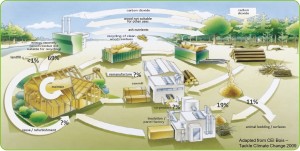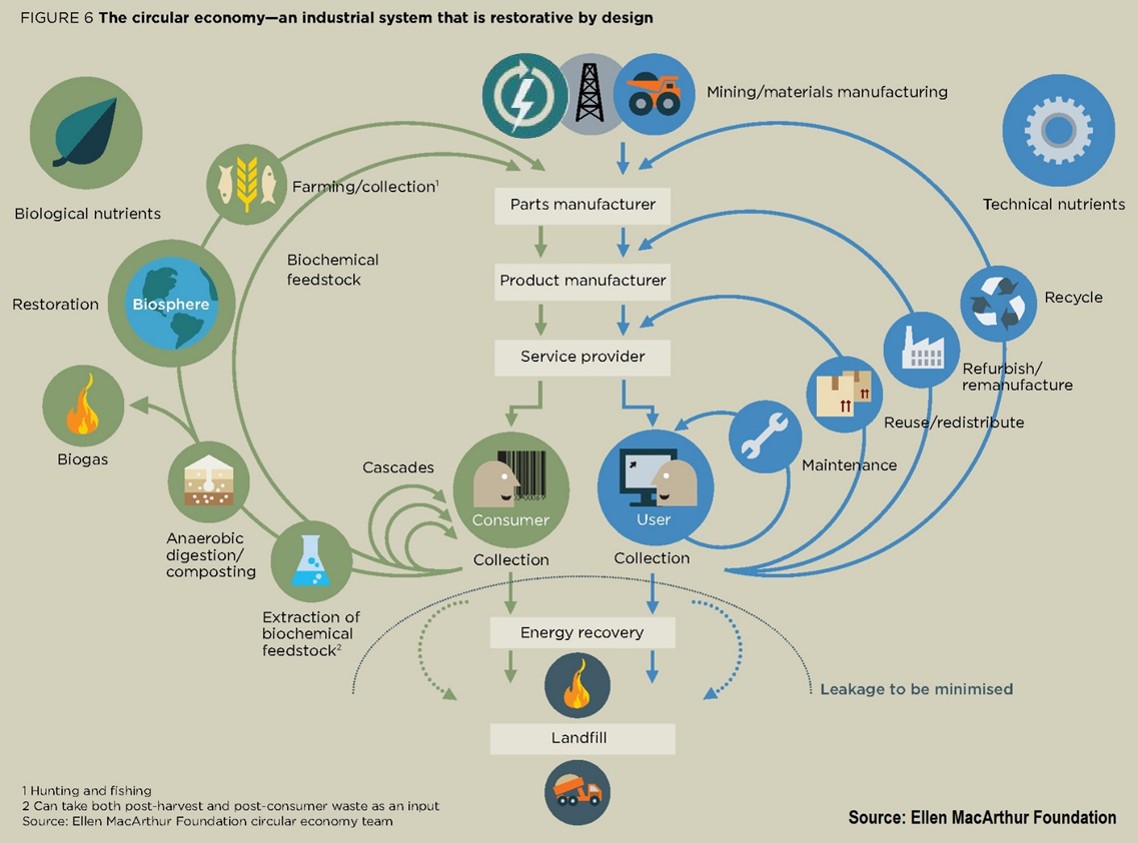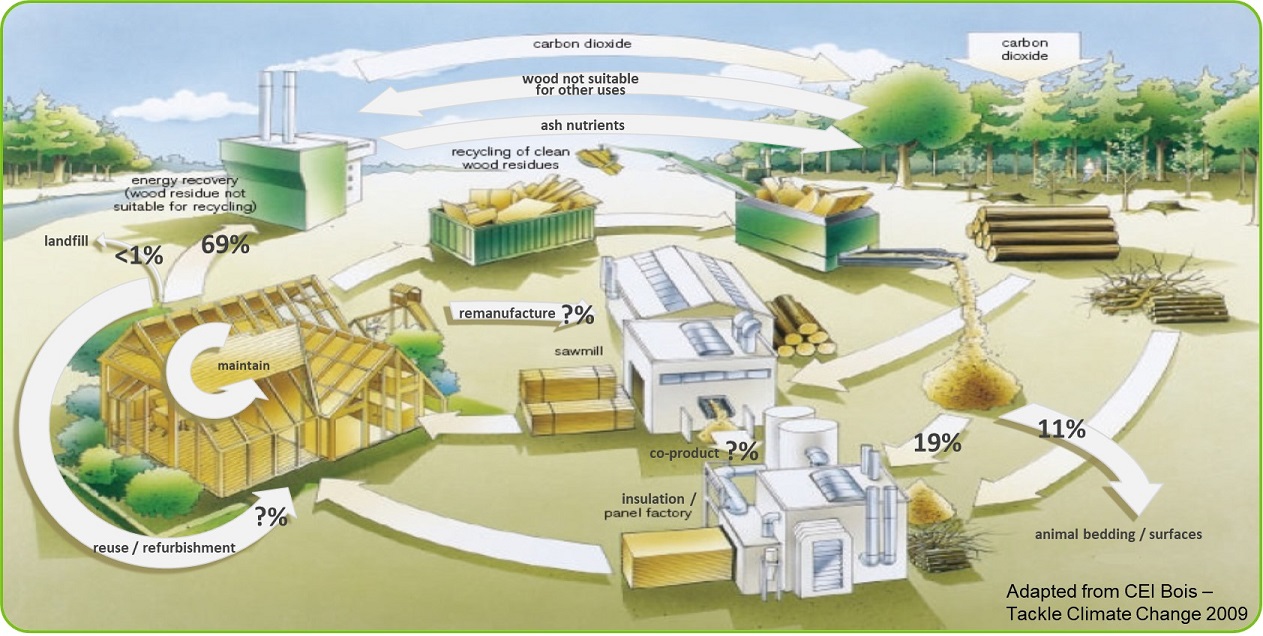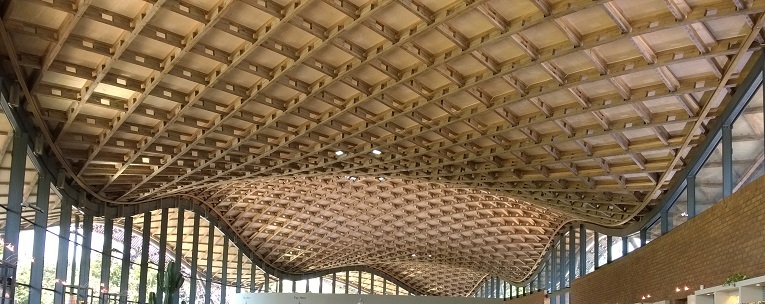Timber and the circular economy

Charlie Law May 2020 Responsible Sourcing / Circular Economy
Introduction to the circular economy
Traditionally, industry has followed the ‘take, make, dispose’ linear consumption model, where resources are taken from the earth to make whatever is needed and the products are disposed of at the end of their life. However, the circular economy is based on the principles of:
- designing out waste
- keeping products and materials in use
- regenerating natural systems.
This means that, if designing something for the long term, ensuring that it be reused or remanufactured at the end of its use cycle, will reduce reliance on the finite resources used to make that product in the first place.
Although this is not a new concept, society has focused on efficiency over the past century and many of these core principles have been ignored. However, in the latter part of the 20th Century, society began to realise that it needed to conserve natural resources and, with Professor Walter Stahel’s ‘Product Life Factor’ paper in 1981, society started to think in loops.
In the 1990s the establishment of the FSC and PEFC chain of custody schemes for timber helped to ensure a sustainable supply. Professor Stahel’s work was also expanded by William McDonough and Michael Braungart who developed the concept of cradle-to-cradle design in their book Rethinking the way we make things, first published in 2002. This introduced the concept of biological and technical nutrient cycles. Then, in 2012, the Ellen MacArthur Foundation produced a great concept infographic, affectionately known as the butterfly diagram, which explains these biological and technical nutrient cycles.

Technical nutrients are generally sourced from finite resources that are extracted from the earth, such as metal ores to make steel or oil to make plastics. To reduce the impact on these finite resources, these materials must be kept in circulation by ensuring they are maintained, reused, refurbished, remanufactured or, as a last resort, recycled.
Biological nutrients are generally sourced from renewable resources such as plants or algae, and prior to returning these resources to the biosphere, as much should be extracted from them as possible (for example by extracting biogas) and resources should be maintained through replanting.
But where does timber fit into this circular economy?
Timber is a biological nutrient and therefore follows the biological cycle, with the possibility of some ‘cascading’ recycling (down-cycling). As can be seen by the CEI Bois diagram from 2009, which shows waste timber and by-products from the processing industry being reused for panel production and energy recovery, the timber industry has been promoting what could be termed a semi-circular business model years.

However, when you look at the numbers, it is clear that more could be done with the timber that has been extracted. The Wood Recyclers Association estimates that 4.5 million tonnes of wood waste was generated in 2018. Of this 877,000 tonnes (19%) was recycled and used for panel board manufacture and 500,000 tonnes (11%) used for animal bedding, equine surfaces, and other recycling purposes. 2.1 million tonnes (47%) went to UK biomass and 313,000 tonnes (7%) was exported for biomass. We know from the Environment Agency waste interrogator data that less than 1% of ‘waste’ timber ends up in landfill. This leaves approximately 665,000 tonnes (15%) unaccounted for, which is likely to have ended up in the ‘refuse derived fuel’ element of waste from materials recovery facilities (MRFs) that is either used in the UK or exported for use as a fuel in energy production.
With ever-increasing energy and resources going into timber production generally, and in particular engineered timber products, should designers look at how these products could be developed to follow the technical cycle, at least initially, and aim to:
- maintain timber products in place for longer,
- refurbish and reuse timber components,
- look at how certain components could be remanufactured?
In addition the timber industry must ensure that it becomes more self-sufficient in its timber production, with the UK being second only to China as the largest net importer of timber and timber products, with more than 60% of our timber requirements being sourced from elsewhere.
Source security and responsible sourcing
The UK must consider the long-term security of its vital timber supplies. Although there is currently a stable supply chain from many countries around the world, particularly those in Europe, for the 60% plus of the UK’s timber requirements, this may not be the case in the long term. The need to reduce carbon emissions from the built environment means that every country will have to look at constructing lower embodied carbon buildings. Timber is a key material in helping to achieve this, which could mean restricted supplies in the future.
There must therefore be a sustainable home-grown timber supply for the future, as well as ensuring more is done with existing resources. For example, only 10% of the hardwood felled in the UK today is used for timber production, much of the remaining 90% is used for biomass, without any previous use. Although the utilisation rates for softwood timber are significantly higher, this demonstrates that this valuable resource is not being used as efficiently as it could be.
Designing for resource efficiency
Doing more with what we have primarily means finding new engineering solutions. Examples of work already done in this area include the Napier University research project, which looked at how the UK could produce cross-laminated timber (CLT) panels from lower strength grade C16 British timber. Another example is the use of small section oak and larch to form the gridshell roof structure of the Savill Building in Windsor Great Park (below), all of which was harvested from trees within the grounds of the Crown Estate.

Future innovations are likely to include the use of 3D-printed components manufactured from wood-fibre biocomposites, particularly for spare parts. This not only reduces the embodied carbon, but also reduces waste production, as only the raw materials required for the part are used, and stock required to be held by merchants, reducing warehouse space and delivery miles. Such innovations must be publicised to ensure they are picked up by industry in good time before a problem with supply arises.
Maintaining timber in place for longer
Existing timber must be maintained for longer, particularly in buildings and other long-term use structures. Traditionally, to make timber last longer, durable species have been sourced from the UK or overseas, or chemically treated non-durable species of softwood timber with hazardous heavy metals such as copper and chromium. However, due to the cost of durable hardwood timbers, and restrictions on the use of the chemical treatments and issues with reuse and disposal at end of life, other innovative solutions are being considered.
One such solution is the thermal modification of timber. The process involves heating the timber to temperatures in excess of 200°C with the addition of steam, which results in the sugars and resins within the wood being cooked off, leaving nothing for insects, fungi and bacteria to feed on, along with converting the components in the wood that hold onto water into those that hold less water. This process means that non-durable hardwood species, such as ash and sycamore, can be converted into a durable product reaching class 1 or 2 durability. This means they should easily last 30 years in external above-ground applications, and with good detailing possibly up to the 60 years indicated for external cladding materials. However, these products are not suitable for the structural building elements, so other alternatives to treatment will need to be used for these applications.
An alternative to thermal modification is the acetylation process pioneered by Accsys Technologies in their Accoya® products, where certain softwood timbers are in effect pickled in an industrial vinegar. This has a similar effect to the thermal modification process, making the wood unpalatable to insects, fungi and bacteria. This has resulted in Accoya® products in external above-ground applications, such as windows and doors, being guaranteed for 50 years, with an expected lifespan much longer than this. This means these products are likely to last at least the 60-year period required for the external skin of a building.
Research into CLT and wetting is continuing with results expected from TRADA this year. Good detailing and construction methods during the build are essential in ensuring the timber does not take on too much moisture before the structure is watertight, and also to allow escape of any moisture that is taken on. There also needs to be good access to areas where timber could be affected by water, such as in toilet and bathroom areas.
Designing for flexibility, deconstruction and disassembly
For these structures to remain relevant, they must be flexible enough to be reconfigured to suit the current user’s needs. This could include the incorporation of float-out wall panels that can open up or close down spaces within a building. It could also mean the incorporation of access panels to provide access for services maintenance.
At end of life, all components of the building need to be dismantled with the intention that they are refurbished as required and reused, or sent for remanufacture into new components. This may mean the use of, for example, quick release connections, such as Sherpa connections for structural timbers, which can be lifted off; or the use of innovative joints installed in products during manufacture, such as the Kährs Woodloc© 5S system, which allows the floor to be dismantled (although something as simple as the use of screws rather than nails for fixing cladding materials would also suffice).
Recycling timber, which in most cases actually means down-cycling (breaking it down into its component elements or materials), should only be considered where maintenance, reuse or remanufacture are not viable options over the life of the building or product.
Business models
To facilitate the take up of the above options, changes in business models will be required. Where components are to be recovered for reuse, refurbishment or remanufacture at the end of their service life, it would be beneficial if the ownership remained with the component supplier. This allows them to control any required maintenance on the component to ensure it remains in use for the required service life, and also the recovery of the component at the end of its service life.
There are various business models that could be used for timber products, and the one used would depend on the intended service life of the component, and the level of maintenance required throughout this life. Possible business models that could be considered are short-term hire, longer-term leasing, service contracts or incentivised return in addition to, or preferably instead of, standard sales contracts.
For example, a removable wood flooring system could be provided on a service contract over a defined period, with the manufacturer also providing a cleaning and maintenance service throughout this period. When the service contract period is completed, the flooring could be removed, refurbished as required, and leased out on a service contract to another client. Another example could be the long-term lease of a component that needs little or no servicing, such as a partition wall system. The wall system would need to be flexible enough to be used in various locations, both on the original site of installation or other similar buildings, where the nominal floor to ceiling height was within a defined tolerance. The manufacturer could then control the installation and removal, and any subsequent refurbishment or remanufacture before being leased to another client.
Conclusion
There is already much innovation in the timber product industry with many products already in place that could easily adapt to a circular economy model. Therefore there is clearly scope for timber product manufacturers to move to a circular economy business model, but this will require a change in the way products are marketed to the construction industry, as well as education and an acceptance of these business models by clients.
This article was previously published in the TRADA Timber 2020 Industry Yearbook.
If you would like us to help you move towards a more circular business model please Contact us>
